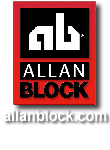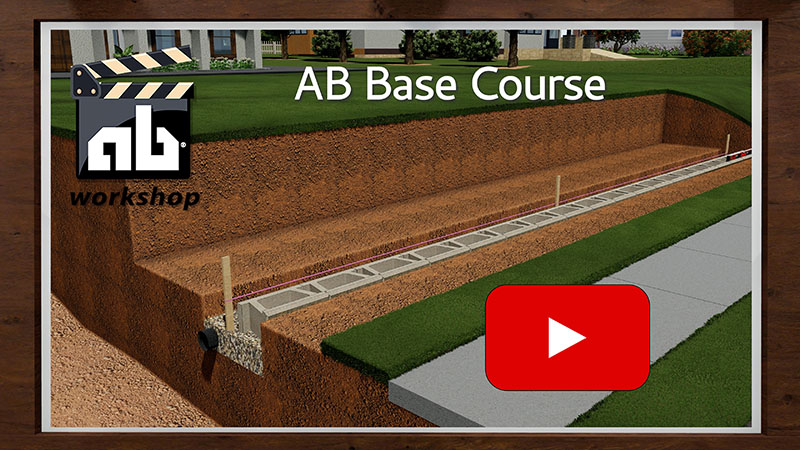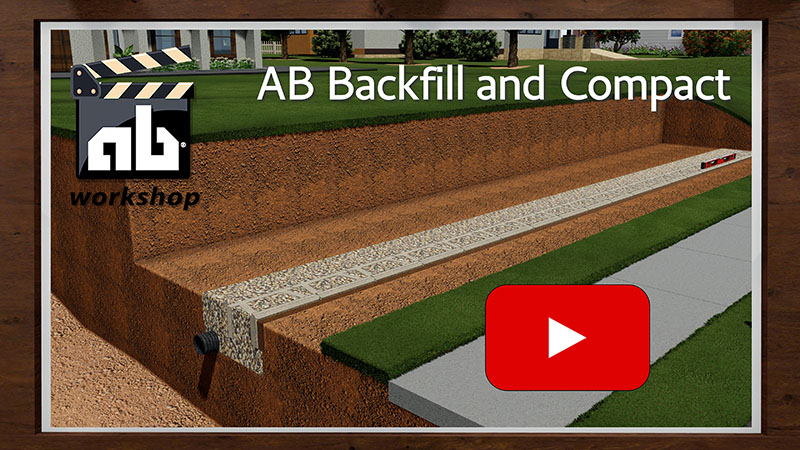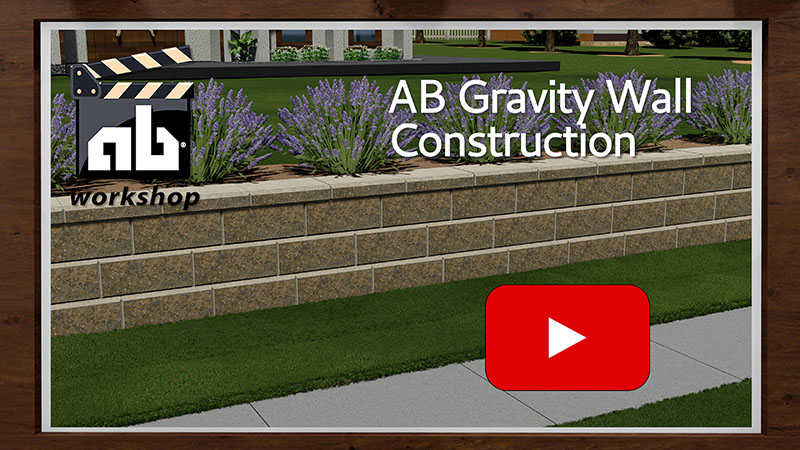How to Build the Base Course (First Course)

Start retaining wall at the lowest elevation
Begin the base course at the lowest wall elevation. More information on retaining walls where the wall steps up a slope.
For AB, AB Aztec, AB Metropolitan & AB Europa Walls
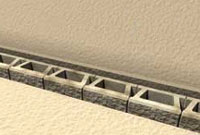
Install the first (base) course

Level and align the blocks

Backfill wall rock & infill soils

Compact the retaining wall

Install next course

Level and align the next course

backfill and compact
- Place all blocks with the raised front lip facing up and forward on the base material near the front of the base trench.
- Check and adjust each block for level and alignment as it is installed. Check the blocks for level frequently from side-to-side and front-to-back. Verify the proper position of all the retaining wall blocks by examining a string line across the back of the blocks or by sighting down the back of the raised front lip.
- Make minor adjustments by tapping the retaining wall blocks with a dead blow hammer or by placing up to 0.5 in. (13 mm) of coarse sand under the blocks.
- Irregularities in the base course become larger as the wall stacks up. Careful attention to a straight and level base course will ensure a quality finished wall.
If you are building with AB Fieldstone that uses recycled materials, go to AB Fieldstone installation
Backfilling and Compaction
- Fill in the area in front of the blocks with on-site soils. This will keep the base course blocks from shifting while filling and compacting.
- Fill the hollow cores of the base course and 12 in. (300 mm) behind the block with wall rock to the height of the block.
- Use infill or approved on-site soils to backfill behind the wall rock in lifts of no more than 8 in. (200 mm).
- Use a plate compactor to consolidate the wall rock directly behind the block then compact in a path parallel to the wall, working from the back of the block to the back of the excavated area with a minimum of 2 passes. More information on compacting your retaining wall.
- Check the base course for level and adjust as necessary.
- Every course after the first course requires compaction starting on the block.
Additional Courses
Learn more on building a patterned retaining wall.
- Remove all excess material from the top surface of all blocks. This can be done when installing the next course of block, by sliding the blocks into place.
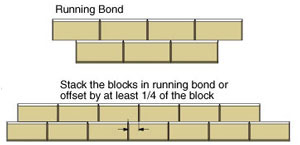
Stack Blocks with vertical seams offset
- If reinforcement is needed, go to reinforced walls to continue the installation process.
- Stack the next course of blocks so that the vertical seams are offset from the blocks below by at least 1/4 the length of the block.
- Check each block for level and alignment and make adjustments as needed.
- Fill the hollow cores and 12 in. (300 mm) behind the block with wall rock to the height of the block.
- Use infill or approved on site soils to backfill behind the wall rock in lifts of no more than 8 in. (200 mm).
- From the 2nd course and above use a plate compactor to compact directly on the blocks as well as the area behind the blocks. Compact in lifts of 8 in. (200 mm) or less.
- Repeating these steps, complete the wall to the desired height. On the last course, fill behind the blocks with organic soils in place of infill or approved on-site soils. This will assist in any plantings above the wall and also to direct water from running behind the blocks. More information on finishing your retaining wall.
For AB Fieldstone Walls

Install facing units
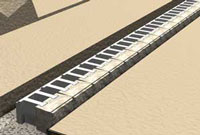
Level and align facing units
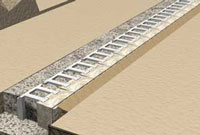
Install anchoring units

Backfill and compact

Remove all excess wall rock material
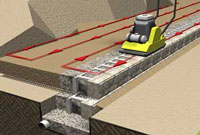
Compact block cores, wall rock and backfill materials
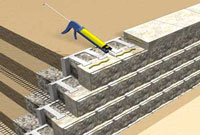
Finish with capstones and secure in place
Using AB Fieldstone's two piece system for straight walls is quick and easy.

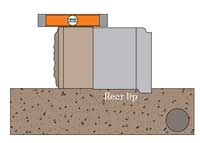
The anchoring unit should never be installed higher than the facing unit and should be reasonably level
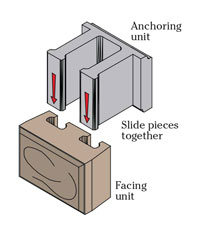
- Begin at the lowest wall elevation by placing the AB Fieldstone facing units on the base material towards the front of the trench, leaving room for the AB Fieldstone anchoring unit. Check each unit and adjust for level and alignment. The facing units can be randomly flipped upside down to give different facing appearances.
- For proper placement of the anchoring units, use a brick hammer or shovel to create a small trench to allow for the lip.
- Install the anchoring units, which are made out of recycled materials, into the receiving slots of the facing units with the lip facing down in the trench just created. Make adjustments to ensure anchoring units are installed reasonably level with the facing unit. The anchoring units should never be installed higher than the facing unit. Except for special applications like corners, each anchoring unit should match up with one facing unit.
- A drain pipe is required for any reinforced wall, gravity walls over 4 ft. (1.2 m) tall or sites with poor drainage. Place the drain pipe at the lowest possible point toward the back of the trench and vent to daylight every 50 ft. (15 m). See approved plans for location and specifications. Learn more about water management.
Install Wall Rock and Backfill Materials
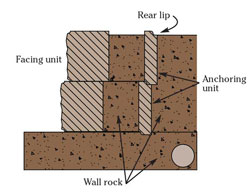
Backfill with wall rock
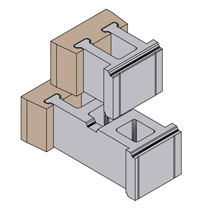
The long anchoring unit (LAU) and short anchoring unit (SAU) can be used together to finish off the top of taller gravity walls. the LAU allows for placement of the rear lip from the unit above.
- Fill the hollow cores and a minimum of 12 in. (300 mm) behind the wall with wall rock. Install the wall rock to be level or below the receiving notch of the anchoring unit.
- Use approved soils to backfill behind the wall rock and in front of the base course.
- Use a plate compactor to consolidate the area behind the blocks.
- Compact in lifts of 8 in. (200 mm) or less
Additional Courses for AB Fieldstone
- Remove all excess material from the top surface of the AB Fieldstone units. This should include running a brush or broom across the receiving notch to remove any debris.
- If reinforcement is needed, check your approved plans for exact size and course location. More information on reinforcing your landscape wall.
- For faster installation and alignment of the second course, install the first AB Fieldstone facing unit and AB Fieldstone anchoring unit at the same time. Make adjustments so that the vertical seams are offset from the blocks below by at least 3 in. (75 mm) or ¼ the length of block.
- Install the rest of the facing units using the first block as a placement guide.
- Place anchoring units into the receiving slots of the facing units. Slide the two piece assembly so that the lip of the anchoring unit is placed into the receiving notch of the block on the course below. Each anchoring unit should match up with one facing unit.
- Check and adjust for level and alignment of the facing units.
- Fill the hollow cores and a minimum of 12 in. (300 mm) behind the wall with wall rock. Install the wall rock behind the anchoring unit to be level or below the receiving notch or approximately 0.5 in. (12 mm) below the top of the anchoring unit.
- Use approved soils to backfill behind the wall rock.
- From course 2 and above use a plate compactor to compact directly on the blocks as well as the area behind the blocks. Compact in lifts of 8 in. (200 mm) or less.
- Remove excess material from the top surface and repeat steps to complete the wall to the height required. More for information on ending walls with turn-ins.

